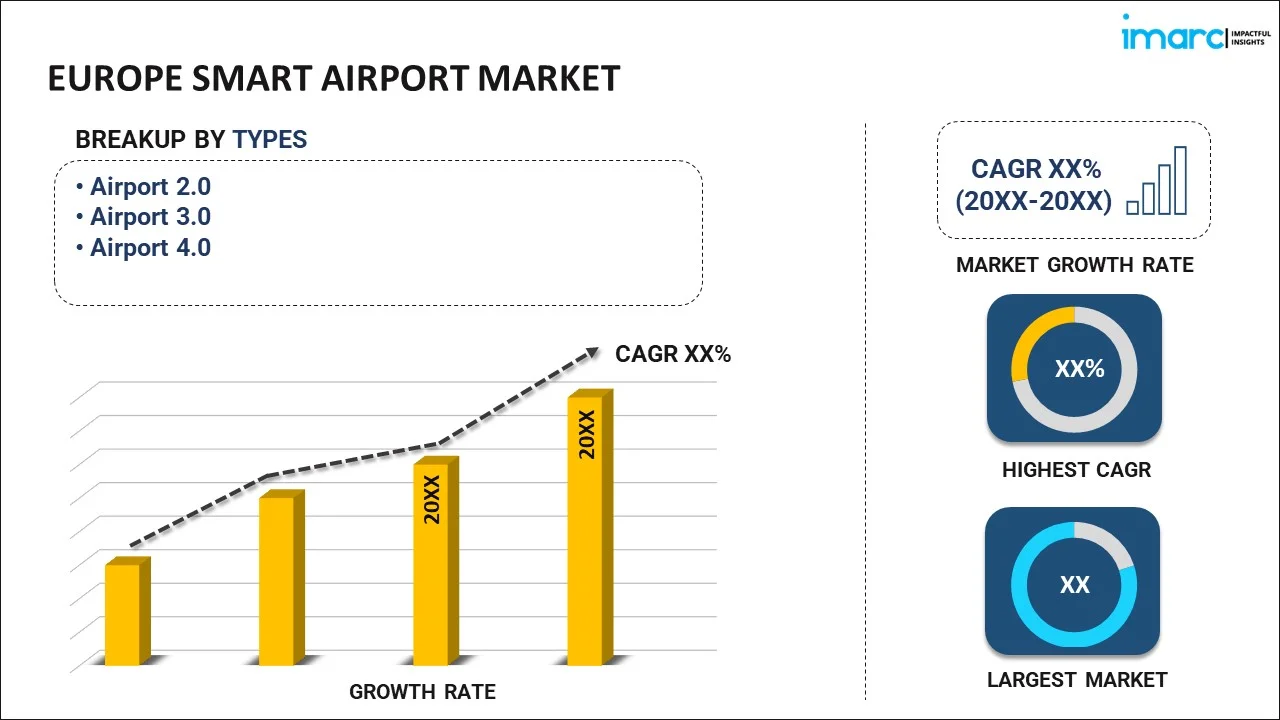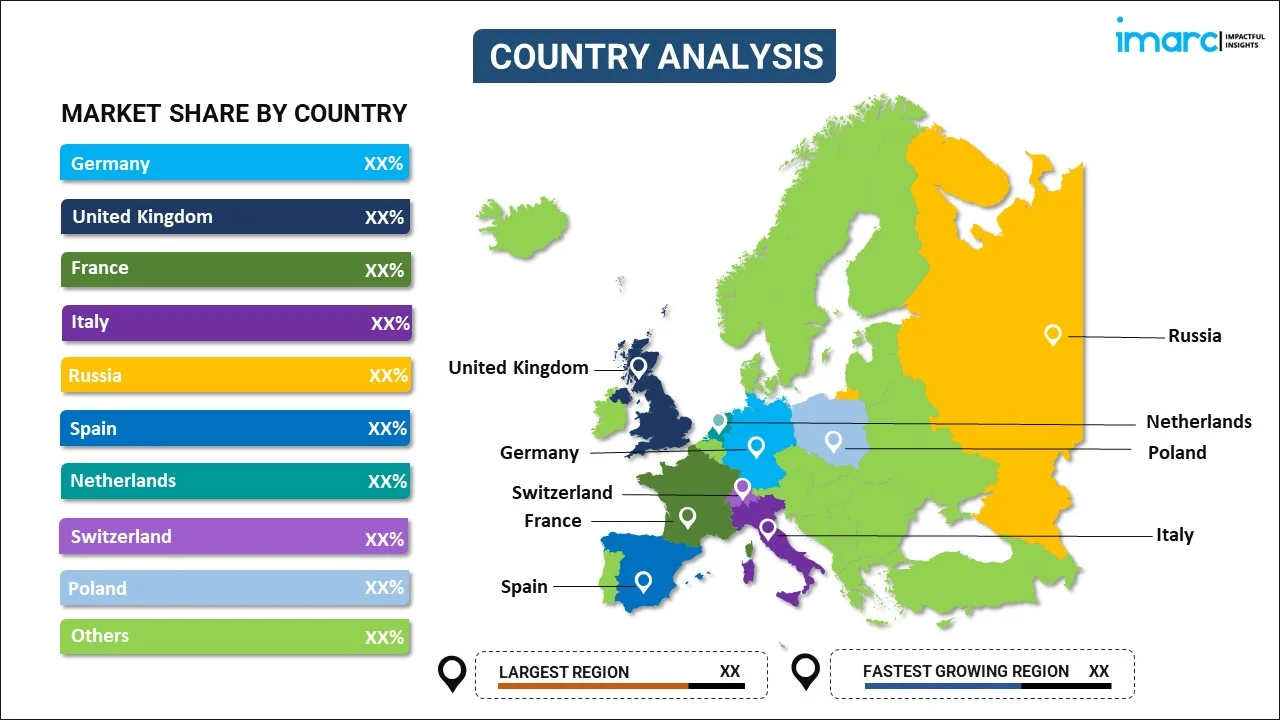
Europe Smart Airport Market Report by Type (Airport 2.0, Airport 3.0, Airport 4.0), Size (Large, Medium, Small), System (Wearables, LPWAN and WLAN, Tags and Sensors, Platforms, NFC, RFID and Bluetooth, Wireless, and Others), Operation (Aeronautical, Non-Aeronautical), End Market (Implementation, Upgrade and Services), Application (Airside, Air Traffic Maintenance, Aircraft Maintenance, Passenger Screening and Experience, Digital Video Surveillance and Management, Building Management, Intelligent Advertising, and Others), and Country 2025-2033
Market Overview:
Europe smart airport market size is projected to exhibit a growth rate (CAGR) of 8.90% during 2025-2033. The increasing focus on improving passenger satisfaction and convenience through technologies, such as mobile check-ins, self-service kiosks, and personalized services, is primarily driving the market growth across the country.
|
Report Attribute
|
Key Statistics
|
|---|---|
|
Base Year
|
2024 |
|
Forecast Years
|
2025-2033
|
|
Historical Years
|
2019-2024
|
| Market Growth Rate (2025-2033) | 8.90% |
A smart airport integrates advanced technologies to enhance efficiency, passenger experience, and overall operational effectiveness. These airports leverage cutting-edge innovations like IoT (Internet of Things), AI (artificial intelligence), and data analytics to streamline processes such as check-in, security, and baggage handling. Smart airports deploy smart sensors to monitor and manage various aspects of airport operations, from crowd control to resource optimization. They also incorporate digital communication platforms, providing real-time information to passengers, improving wayfinding, and reducing queuing times. Additionally, these airports often implement sustainable practices and eco-friendly solutions to minimize their environmental impact. The overarching goal of a smart airport is to create a seamlessly connected, technologically advanced ecosystem that enhances both the efficiency and passenger satisfaction of air travel.
Europe Smart Airport Market Trends:
The smart airport market in Europe is experiencing significant growth, propelled by various drivers that are reshaping the aviation industry. Firstly, the increasing demand for seamless and efficient passenger experiences is a key catalyst. The integration of smart technologies, such as biometric identification and automated check-in processes, enhances overall travel efficiency. Furthermore, the rising regional air traffic is fostering the adoption of smart airport solutions to manage the growing passenger volumes. Additionally, governments and airport authorities are investing in smart infrastructure to enhance security measures and ensure regulatory compliance. Moreover, the emergence of IoT and connected devices plays a pivotal role in shaping the smart airport landscape. These technologies facilitate real-time data exchange, enabling airports to optimize operations, enhance communication, and improve overall situational awareness. The ongoing digital transformation in the aviation sector, including the deployment of AI and data analytics, is another significant driver. These innovations contribute to predictive maintenance, resource optimization, and operational cost reductions, thereby attracting investments in smart airport solutions. In conclusion, the convergence of technological advancements, increasing passenger demands, and a proactive industry approach are driving the robust growth of the smart airport market in Brazil.
Europe Smart Airport Market Segmentation:
IMARC Group provides an analysis of the key trends in each segment of the market, along with forecasts at the regional and country levels for 2025-2033. Our report has categorized the market based on type, size, system, operation, end market, and application.
Type Insights:

- Airport 2.0
- Airport 3.0
- Airport 4.0
The report has provided a detailed breakup and analysis of the market based on the type. This includes airport 2.0, airport 3.0, and airport 4.0.
Size Insights:
- Large
- Medium
- Small
A detailed breakup and analysis of the market based on the size have also been provided in the report. This includes large, medium, and small.
System Insights:
- Wearables
- LPWAN and WLAN
- Tags and Sensors
- Platforms
- NFC, RFID and Bluetooth
- Wireless
- Others
The report has provided a detailed breakup and analysis of the market based on the system. This includes wearables, LPWAN and WLAN, tags and sensors, platforms, NFC, RFID and bluetooth, wireless, and others.
Operation Insights:
- Aeronautical
- Non-Aeronautical
A detailed breakup and analysis of the market based on the operation have also been provided in the report. This includes aeronautical and non-aeronautical.
End Market Insights:
- Implementation
- Upgrade and Services
The report has provided a detailed breakup and analysis of the market based on end market. This includes implementation and upgrade and services.
Application Insights:
- Airside
- Air Traffic Maintenance
- Aircraft Maintenance
- Passenger Screening and Experience
- Digital Video Surveillance and Management
- Building Management
- Intelligent Advertising
- Others
A detailed breakup and analysis of the market based on the application have also been provided in the report. This includes airside, air traffic maintenance, aircraft maintenance, passenger screening and experience, digital video surveillance and management, building management, intelligent advertising, and others.
Country Insights:

- Germany
- United Kingdom
- France
- Italy
- Russia
- Spain
- Netherlands
- Switzerland
- Poland
- Others
The report has also provided a comprehensive analysis of all the major regional markets, which include Germany, United Kingdom, France, Italy, Russia, Spain, Netherlands, Switzerland, Poland, and Others.
Competitive Landscape:
The market research report has also provided a comprehensive analysis of the competitive landscape. Competitive analysis such as market structure, key player positioning, top winning strategies, competitive dashboard, and company evaluation quadrant has been covered in the report. Also, detailed profiles of all major companies have been provided.
Europe Smart Airport Market Report Coverage:
| Report Features | Details |
|---|---|
| Base Year of the Analysis | 2024 |
| Historical Period | 2019-2024 |
| Forecast Period | 2025-2033 |
| Units | US$ Million |
| Scope of the Report | Exploration of Historical Trends and Market Outlook, Industry Catalysts and Challenges, Segment-Wise Historical and Future Market Assessment:
|
| Types Covered | Airport 2.0, Airport 3.0, Airport 4.0 |
| Sizes Covered | Large, Medium, Small |
| Systems Covered | Wearables, LPWAN and WLAN, Tags and Sensors, Platforms, NFC, RFID and Bluetooth, Wireless, Others |
| Operations Covered | Aeronautical, Non-Aeronautical |
| End Markets Covered | Implementation, Upgrade and Services |
| Applications Covered | Airside, Air Traffic Maintenance, Aircraft Maintenance, Passenger Screening and Experience, Digital Video Surveillance and Management, Building Management, Intelligent Advertising, Others |
| Countries Covered | Germany, United Kingdom, France, Italy, Russia, Spain, Netherlands, Switzerland, Poland, Others |
| Customization Scope | 10% Free Customization |
| Report Price and Purchase Option | Single User License: US$ 3699 Five User License: US$ 4699 Corporate User License: US$ 5699 |
| Post-Sale Analyst Support | 10-12 Weeks |
| Delivery Format | PDF and Excel through Email (We can also provide the editable version of the report in PPT/Word format on special request) |
Key Questions Answered in This Report:
- How has the Europe smart airport market performed so far and how will it perform in the coming years?
- What has been the impact of COVID-19 on the Europe smart airport market?
- What is the breakup of the Europe smart airport market on the basis of type?
- What is the breakup of the Europe smart airport market on the basis of size?
- What is the breakup of the Europe smart airport market on the basis of system?
- What is the breakup of the Europe smart airport market on the basis of operation?
- What is the breakup of the Europe smart airport market on the basis of end market?
- What is the breakup of the Europe smart airport market on the basis of application?
- What are the various stages in the value chain of the Europe smart airport market?
- What are the key driving factors and challenges in the Europe smart airport?
- What is the structure of the Europe smart airport market and who are the key players?
- What is the degree of competition in the Europe smart airport market?
Key Benefits for Stakeholders:
- IMARC’s industry report offers a comprehensive quantitative analysis of various market segments, historical and current market trends, market forecasts, and dynamics of the Europe smart airport market from 2019-2033.
- The research report provides the latest information on the market drivers, challenges, and opportunities in the Europe smart airport market.
- Porter's five forces analysis assist stakeholders in assessing the impact of new entrants, competitive rivalry, supplier power, buyer power, and the threat of substitution. It helps stakeholders to analyze the level of competition within the Europe smart airport industry and its attractiveness.
- Competitive landscape allows stakeholders to understand their competitive environment and provides an insight into the current positions of key players in the market.
Need more help?
- Speak to our experienced analysts for insights on the current market scenarios.
- Include additional segments and countries to customize the report as per your requirement.
- Gain an unparalleled competitive advantage in your domain by understanding how to utilize the report and positively impacting your operations and revenue.
- For further assistance, please connect with our analysts.
 Inquire Before Buying
Inquire Before Buying
 Speak to an Analyst
Speak to an Analyst
 Request Brochure
Request Brochure
 Request Customization
Request Customization




.webp)




.webp)












